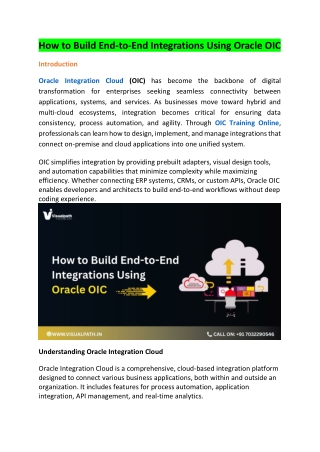
0 likes | 2 Views
Accelerate your IT career with Visualpathu2019s Oracle Integration Cloud programs designed to help you master application integration, automation, and cloud connectivity. Through our Oracle Integration Cloud Online Training, gain hands-on experience, real-time project exposure, and expert guidance from certified professionals. Advance your skills with our comprehensive OIC Online Training and prepare for global career success. Call 91-7032290546 today.<br>Visit:https://www.visualpath.in/oracle-integration-cloud-training.html<br>WhatsApp: https://wa.me/c/917032290546 <br>Blog: https://visualpathblogs.com/o

E N D
How to Build End-to-End Integrations Using Oracle OIC Introduction Oracle Integration Cloud (OIC) has become the backbone of digital transformation for enterprises seeking seamless connectivity between applications, systems, and services. As businesses move toward hybrid and multi-cloud ecosystems, integration becomes critical for ensuring data consistency, process automation, and agility. Through OIC Training Online, professionals can learn how to design, implement, and manage integrations that connect on-premise and cloud applications into one unified system. OIC simplifies integration by providing prebuilt adapters, visual design tools, and automation capabilities that minimize complexity while maximizing efficiency. Whether connecting ERP systems, CRMs, or custom APIs, Oracle OIC enables developers and architects to build end-to-end workflows without deep coding experience. Understanding Oracle Integration Cloud Oracle Integration Cloud is a comprehensive, cloud-based integration platform designed to connect various business applications, both within and outside an organization. It includes features for process automation, application integration, API management, and real-time analytics.
What sets OIC apart is its low-code development environment, which allows users to design workflows using intuitive drag-and-drop interfaces. This reduces the dependency on traditional coding and speeds up the deployment of integration projects. Moreover, OIC provides prebuilt connectivity to major enterprise systems such as Oracle ERP Cloud, Salesforce, SAP, and Workday. Its rich library of adapters simplifies data synchronization, enabling faster and more reliable communication between diverse applications. Step-by-Step: Building an End-to-End Integration Building an end-to-end integration using Oracle OIC involves a structured process that focuses on design, connection, transformation, and monitoring. Let’s break down the steps: 1. Identify Integration Requirements The first step is to analyze which systems need to communicate. Identify the data flow direction—whether it’s one-way or bi-directional—and determine what data elements should be exchanged. 2. Choose the Right Adapters Oracle OIC offers a wide range of prebuilt adapters for cloud and on-premise applications. For example, you can use the Salesforce adapter to connect your CRM or the Oracle ERP adapter to integrate financial data. Choosing the right adapter ensures compatibility and reduces development time. 3. Create and Configure Connections Once adapters are selected, you need to establish connections by providing endpoint details and authentication credentials. These connections act as the foundation for all integration flows within OIC. At this point, many professionals gain hands-on experience through a structured Oracle Integration Cloud Course, which teaches them to manage authentication methods, handle security policies, and optimize data mapping between applications.
4. Design the Integration Flow Using the OIC integration designer, developers can visually map out workflows. Each flow typically includes triggers, data mappings, and business logic steps. OIC’s visual mapper allows you to transform data formats between source and target applications effortlessly. You can also add conditional logic, error handling, and orchestration to create more dynamic and resilient integrations. 5. Deploy and Test After building the integration, deploy it to a test environment. Oracle OIC provides testing tools to simulate requests, validate mappings, and ensure the integration performs as expected. Logs and dashboards offer real-time insights into data movement and any potential errors. Monitoring and Managing Integrations Once the integration is live, it’s important to monitor its performance and maintain reliability. Oracle OIC includes built-in analytics and monitoring dashboards that display metrics such as throughput, latency, and error rates. Administrators can set alerts for specific events, ensuring issues are detected and resolved quickly. This proactive approach helps maintain seamless business continuity. Furthermore, integration projects often need scaling as organizations grow. OIC makes it easy to modify or extend existing integrations without disrupting live operations. Many professionals acquire these advanced skills from an Oracle Integration Cloud Training Institute, where real-time projects and case studies help them tackle complex enterprise challenges. Best Practices for End-to-End Integration 1.Use Prebuilt Templates:Start with Oracle’s preconfigured integration patterns to save time. 2.Implement Data Governance: Ensure consistent data mapping across all connected systems.
3.Automate Error Handling: Configure automated retries and notifications for failed transactions. 4.Secure Your Integrations: Always use encryption, secure tokens, and proper access control. 5.Monitor Continuously: Regularly analyze performance dashboards to identify bottlenecks early. By following these best practices, teams can build robust integrations that align with their business goals. Conclusion Building end-to-end integrations using Oracle Integration Cloud is not just about connecting systems—it’s about creating a foundation for intelligent automation and seamless data exchange. OIC’s user-friendly interface, strong security framework, and prebuilt connectors enable organizations to modernize workflows efficiently. As businesses evolve, Oracle OIC will continue to play a crucial role in helping them achieve scalability, agility, and digital excellence. TRENDING COURSES: AWS Data Engineering, GCP Data Engineering, SAP Datasphere. Visualpath Visualpath is the Leading and Best Software Online Training Institute in Hyderabad is the Leading and Best Software Online Training Institute in Hyderabad. . bout Best Oracle Integration Cloud For More Information a For More Information about Best Contact Call/WhatsApp: Contact Call/WhatsApp: +91 +91- -7032290546 7032290546 Visit: Visit: https://www.visualpath.in/oracle-integration-cloud-training.html